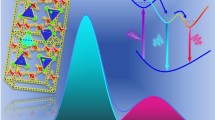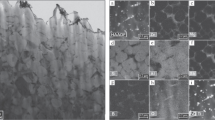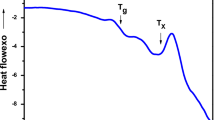Abstract
Infrared to green up-conversion emissions centered at the wavelengths of about 524 and 550 nm of the Er3+-Yb3+ codoped borosilicate glass are recorded, using a 978 nm semiconductor laser diode (LD) as an excitation source. The fluorescence intensity ratio (FIR) of the green up-conversion emissions at about 524 and 550 nm in the Er3+-Yb3+ codoped borosilicate glass has been studied as a function of temperature over the temperature range of 295–873 K. The maximum sensitivity and the temperature resolution derived from the FIR of the green up-conversion emissions are approximately 0.0038 K−1 and 0.2 K, respectively. It is demonstrated that the prototype optical temperature sensor based on the FIR technique from the green up-conversion emissions in the Er3+-Yb3+ codoped borosilicate glass plays a major role in temperature measurement.
Similar content being viewed by others
References
Maciel G S, Biswas A, Prasad P N. Infrared-to-visible Eu3+ energy upconversion due to cooperative energy transfer from an Yb3+ ion pair in a sol-gel processed multi-component silica glass. Opt Commun, 2000, 178: 65–69
Rai V K, Rai D K, Rai S B. Pr3+ doped lithium tellurite glass as a temperature sensor. Sens Actuators A, 2006, 128: 14–17
Dong B, Cao B S, Feng Z Q, et al. Upconversion emissions of Er3+-Yb3+ codoped Al2O3 nanoparticles by the arc discharge synthesis method. Sci China Ser G-Phys Mech Astron, 2009, 52: 1043–1046
Chen X B, Song Z F, Wu J G, et al. Ultraviolet and visible upconversion luminescence of Tm(0.1)Yb(0.5): FOV oxyfluoride nanophase vitroceramics. Sci China Ser G-Phys Mech Astron, 2008, 51: 1868–1876
Luo L, Zhang X X, Li K F, et al. Er/Yb doped porous silicon-A novel white light source. Adv Mater, 2004, 16: 1664–1667
Vetrone F, Boyer J C, Capobianco J A, et al. Significance of Yb3+ concentration on the upconversion mechanisms in codoped Y2O3:Er3+, Yb3+ nanocrystals. J Appl Phys, 2004, 96: 661–667
Maurice E, Monnom G, Saissy A, et al. Thermalization effects between upper levels of green fluorescence in Er-doped silica fibers. Opt Lett, 1994, 13: 990–992
Wade S A, Collins S F, Baxter G W. Fluorescence intensity ratio technique for optical fiber point temperature sensing. J Appl Phys, 2003, 94: 4743–4756
Singh S K, Kumar K, Rai S B. Er3+/Yb3+ codoped Gd2O3 nano-phosphor for optical thermometry. Sens Actuators A, 2009, 149: 16–20
Maciel G S, de Menezes L S, Gomes A S L. Temperature sensor based on frequency upconversion in Er3+-doped fluoroindate glass. IEEE Photon Tech Lett, 1995, 7: 1474–1476
dos Santos P V, de Araujo M T, Gouveia-Neto A S, et al. Optical temperature sensing using upconversion fluorescence emission in Er3+ /Yb3+ -codoped chalcogenide glass. Appl Phys Lett, 1998, 73: 578–580
Li Y G, Liu L Y, He Z, et al. Improvement of fluorescence lifetime from Er-doped Sol-gel silica glass by dehydration in CCl4. J Sol-Gel Sci Tech, 2004, 30: 29–33
Author information
Authors and Affiliations
Corresponding author
Rights and permissions
About this article
Cite this article
Feng, Z., Bai, L., Cao, B. et al. Er3+-Yb3+ codoped borosilicate glass for optical thermometry. Sci. China Phys. Mech. Astron. 53, 848–851 (2010). https://doi.org/10.1007/s11433-010-0188-9
Received:
Accepted:
Published:
Issue Date:
DOI: https://doi.org/10.1007/s11433-010-0188-9




